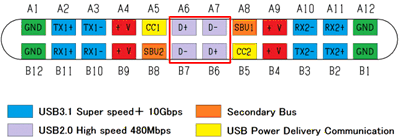ZHCSGS1A September 2017 – September 2017 TS5USBC400
PRODUCTION DATA.
8.1 Overview
The TS5USBC400 is a bidirectional low-power dual port, high-speed, USB 2.0 analog switch with integrated protection for USB Type-C systems. The device is configured as a dual 2:1 or 1:2 switch and is optimized for handling the USB 2.0 D+/- lines in a USB Type-C system as shown in Figure 13.
 Figure 13. USB Type-C Connector Pinout
Figure 13. USB Type-C Connector PinoutThe TS5USBC400 also works in traditional USB systems that need protection from fault conditions such as automotive and applications that require higher voltage charging. The device maintains excellent signal integrity through the optimization of both RON and BW while protecting the system with 0 V to 16 V OVP protection. The OVP implementation is designed to protect sensitive system components behind the switch that cannot survive a fault condition where VBUS is shorted the D+ and D- pins on the connector.